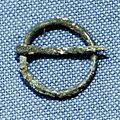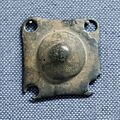Muntham Court Romano-British site facts for kids
Quick facts for kids Muntham Court Romano-British site |
|
|---|---|

View of the site from south-eastern side, overlooking approximate location of the settlements
|
|
| Location | Findon |
| OS grid reference | TQ 11105 09314 |
| Official name: Muntham Court Romano-British site | |
| Reference no. | 1005850 |
| Lua error in Module:Location_map at line 420: attempt to index field 'wikibase' (a nil value). | |
The Muntham Court Romano-British site is an amazing old place near Findon in West Sussex. It's a special protected area because it holds clues about people who lived there long, long ago. This site shows us how people lived during the Iron Age and when the Romans were in Britain.
Contents
Discovering Muntham Court
This important site was dug up, or excavated, in the 1950s. Two people, Mr. G.P. Burstow and Mr. G.A. Holleyman, led the work. They found a large settlement from the late Iron Age and the time when the Romans were in Britain.
Homes and Roads from the Past
The archaeologists found signs of houses, old paths, and even field boundaries. They also found what might have been a temple or a special shrine. Close by, there's a very deep well, about 76 meters deep! Imagine how much water that could hold.
Life in the Iron Age
The oldest part of the settlement is at the top of the hill. Here, hundreds of holes in the ground show where wooden posts once stood. These posts probably held up huts where people lived and racks for drying corn. There was also a pit for storing food.
The settlement had a fence, called a palisade, and a shallow ditch to protect it. Things found from this time include pieces of pottery, tools for spinning thread, and weights for weaving cloth. They even found a piece of a very old stone hammer from the Bronze Age!
The Roman Temple Mystery
At the very top of the hill, you can still see a circular dip in the ground. This is where a Roman temple or shrine once stood. It was about 11 meters wide. This temple was made of wood, not stone, and had two main parts. We know this from the patterns of post-holes left in the ground.
A small copper plaque shaped like a wild boar was found here. It might have been linked to another Roman temple at Chanctonbury Ring. You can see this boar plaque and other cool items, like a fish-shaped brooch and a musical instrument mouthpiece, at the Worthing Museum and Art Gallery.
Cool Finds from Muntham Court
Many amazing objects found at Muntham Court are now kept at the Worthing Museum and Art Gallery. These finds help us understand what life was like for people living here thousands of years ago.
- Boar Plaque: A small copper plaque showing a charging wild boar. It's about 10 cm long and 4 cm wide. It was made between the 1st and 4th centuries AD.
- Enamelled Fish Brooch: A beautiful brooch shaped like a fish. It's about 3 cm long and has blue, red, and green colours. This was made in the 2nd century AD.
- Model Leg: A simple clay model of a human leg. We don't know exactly when it was made, but it's a unique find!
- Needle and Hairpin: A bone needle (8.5 cm long) and a bone hairpin (5 cm long). These were used for sewing and styling hair. They are from the 1st to 4th centuries AD.
- Penannular Brooch: A small metal brooch, about 2.6 cm across. It's a type of Celtic brooch and was made between the 1st and 2nd centuries AD.
- Sceptre Pommel: A hollow copper object, about 10.5 cm long. It might have been the top part of a sceptre, a special staff carried by important people. It's from the 1st to 4th centuries AD.
- Shield Boss: A copper piece that would have been in the middle of a shield. It has holes in the corners for attaching it. This is also from the 1st to 4th centuries AD.
- Ornamented Stud: A decorative stud, about 2.3 cm wide. It's made of copper alloy and dates from the 1st to 4th centuries AD.
- Wire Tongs: Thin copper wire tongs, about 10 cm long when bent. These were used for gripping small items. They are from the 1st to 4th centuries AD.
Images for kids










